
Table of Contents:
– Background
– Look and Feel
– Reticle Options
– Comparative Optical Evaluation
– Mechanical Testing
– Summary and Conclusion
– Your Pro and Con Breakdown
– Testing Methodology
Background:
For those who don’t know, Bushnell is part of Vista Outdoor, a company with a bunch of outdoor brands that was spun off of the behemoth Alliant Techsystems in 2015. Soon, there will be another division that will see the ammo brands under Vista such as CCI and Federal becoming a company called Kinetic group with stock ticker “HUNT” And the gear companies including Bushy, RCBS, Camelbak, and Giro housed under the name Revelyst with ticker “GEAR.” I mention this because over time, and as a whole, this group seems to me to be getting leaner, better organized, and more knowledgeable, with improving product lines. This year at SHOT for instance, Bushy had abandoned its former huge disorganized booth for a smaller booth featuring several Vista brands which was staffed with far more well-informed people than I have encountered in past years. I was able to talk industry direction, competition demands, and upcoming product plans such as calypso wind meter integration with laser rangefinders. We even went into some technical minutia of Bushnell products as well as some from competing brands. A clear pipeline of knowledgeable individuals now seems to exist between dudes who are using the products at a high level, such as Bushy’s shooting team, and the people making the decisions. The result of this is timely products well-positioned in the market. I expect that the smaller, more focused company arrangements are helping with this and I have liked many of the recent products put out by Vista, from the RCBS MatchMaster stuff I looked at a few years ago to the Bushnell XRS3 6-36×56 a year and a half or so ago. To a large degree, that XRS3 is the reason for this review. The optical performance it put out at the price was class-leading, despite the fact that the XRS3 was the least expensive product in the lineup. When I saw a new Bushnell putting out a new feature-rich scope intended for a lower price bracket but basically the same market, I was very interested.
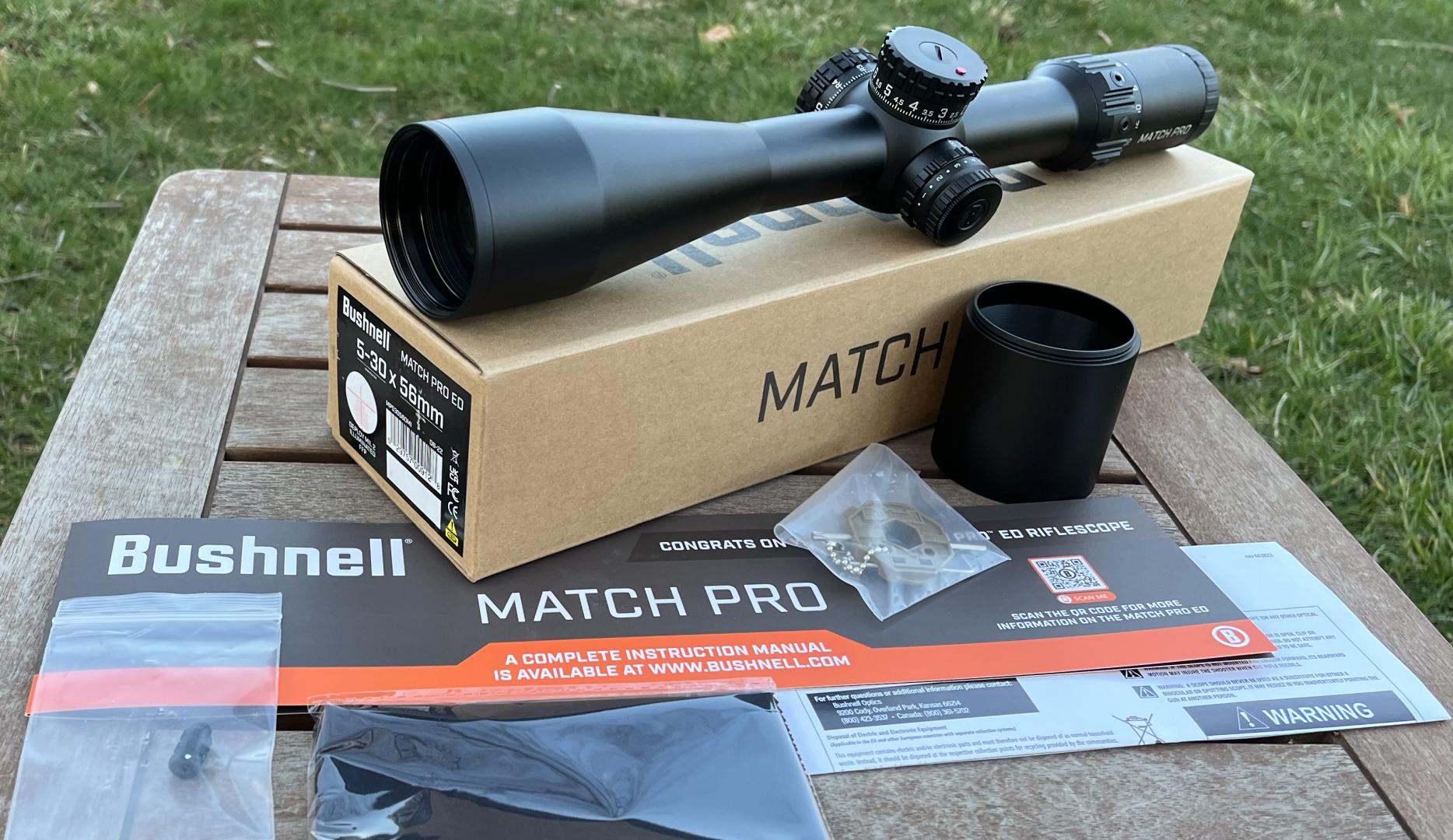
Look and Feel:
The Bushnell Match Pro ED 5-30x56mm comes in a crappy cardboard box. It’s probably the worst I have seen since the days of the U.S. Optics SN3 and their generic white box with USO printed tape around it. Like that box, the Bushy box also has the product information affixed to it with a sticker on the end cap. Glorious – I can’t help but smile. You’re not paying for the box: It’s a statement. From what Bushy tells me, it’s a good thing too as the majority of consumers discard the box anyway. What is more, most do not even see they box until after they purchase as scopes in this price range are typically housed under glass in retail outlets and, of course, in contrast to much of the rest of the web, there are no box pics on e-commerce websites. My recommendation is to use the box as kindling. In fact, it is rather suited for that use, as it has no plasticised print layer on the outside to smoke you out with toxic fumes if you do so. What a win.
Inside the fire starter kit, you find that the scope comes with a short sunshade, a lens cloth, Bushy’s nice keychain tool, and a throw lever stud that can be installed in any of three positions on the power ring. A full manual is not included with the scope. Rather, you get an oddly shaped, but pretty well done, quick start guide with a QR code on it linking to the full manual. There is also another scrap of paper with lawyer type compliance stuff in several languages that some government(s) probably requires to be in there. The quick start guide includes most of what you will want for getting you going, such as instructions for setting diopter, throw lever, and the zero stop / rev indicator system.
Speaking of the zero stop / rev indicator system, Bushnell is calling it the Easy-SetTM . It is a 10mil/turn non-translating elevation knob with two-stage pop-up rev indicator and no set screws anywhere. The elevation knob is also locking and can be locked at any point by pushing it down. This is not spring-loaded, so the user can choose to leave it unlocked most of the time. If you’re thinking this is a very feature rich elevation adjustment for a $700 scope – it is. You often find this feature set in $2k+ scopes but I have not seen them in a sub-$1k scope before. This may have something to do with how they are integrated. The full rev indicator and zero stop system of the Bushnell Match Pro ED 5-30x56mm appear to be housed in the part of the turret that you remove while setting the system. I haven’t seen that done before. There is a fringe benefit to this. Unlike most translating elevation turret systems, with the one on this Bushy, you can choose how much travel below zero you have. To set the zero stop and rev indicator, they recommend that you remove the turret and rotate a little ring inside clockwise until it stops and then re-attach the turret with the zero lined up. This gives you no travel below zero. If you instead choose to rotate that ring 5 degrees or so counter-clockwise from the stop point in the clockwise direction, you will get somewhere around .5-1 mils travel below zero when you re-install it lined up at zero, depending on just how far from the stop you rotated it. Not only do I consider this a feature, but also, this whole assembly is designed without a single damned setscrew. That is a huge design win. Almost everybody uses them, but setscrews are still bad design in a scope. They often strip out, scar the surface they interface with, slip, the stupid wrenches get lost or mixed up, and set screw systems can even bind a turret if set with too much or uneven pressure from the several screws. The system Bushy is using here is so much better. I think it’s actually the best system I have seen at any price and it’s on this $700 optic and not my $4k ZCO. I’m enamored, though I can see the possibility for a few easy tweaks to make the design even better. The improvements I can see would be to make the grooved center cap an outie, sort of like a wing nut, and not an innie, such that the whole turret would be completely tool less. I would also add a little more movement range to the zero stop system to increase the travel, as it currently maxes out at 26 mils. This could possibly limit your travel a bit as the scope has about 29.4 mils of internal travel. Given all the factors involved in mounting and such, in practice it is vanishing unlikely too limit you in practice, but in theory, it could.
Like the elevation turret, the windage turret is also 10 mil/turn and has good feel, audible clicks, and good balance between click force so that you can feel and hear every click and not end up skipping over some. The windage turret locks using the same manner as the elevation. It also has a rev stop on it that allows for 8 mils each direction before the stop. This is generally done to prevent tubing out, but it also limits the user’s ability to dial windage if so inclined.
The rest of the specs are pretty normal. The Bushnell Match Pro ED 5-30x56mm has pretty average weight at 32oz and is a little longer than average at about 15.5”. It has a 34mm tube and, as you should know by the name, a 56mm objective. Its parallax focuses down to 15 yards and is pretty stiff. The 11 position rheostat for the illumination is also pretty stiff, whereas the diopter and power ring move with about the amount of force you would expect.
I should also note here that the illumination control on the Match Pro also features an auto-off feature that shuts illumination down 6 hours after the last time the illumination dial is adjusted to prevent battery discharge. This is another feature often found on higher dollar scopes and seldom seen in this price range.
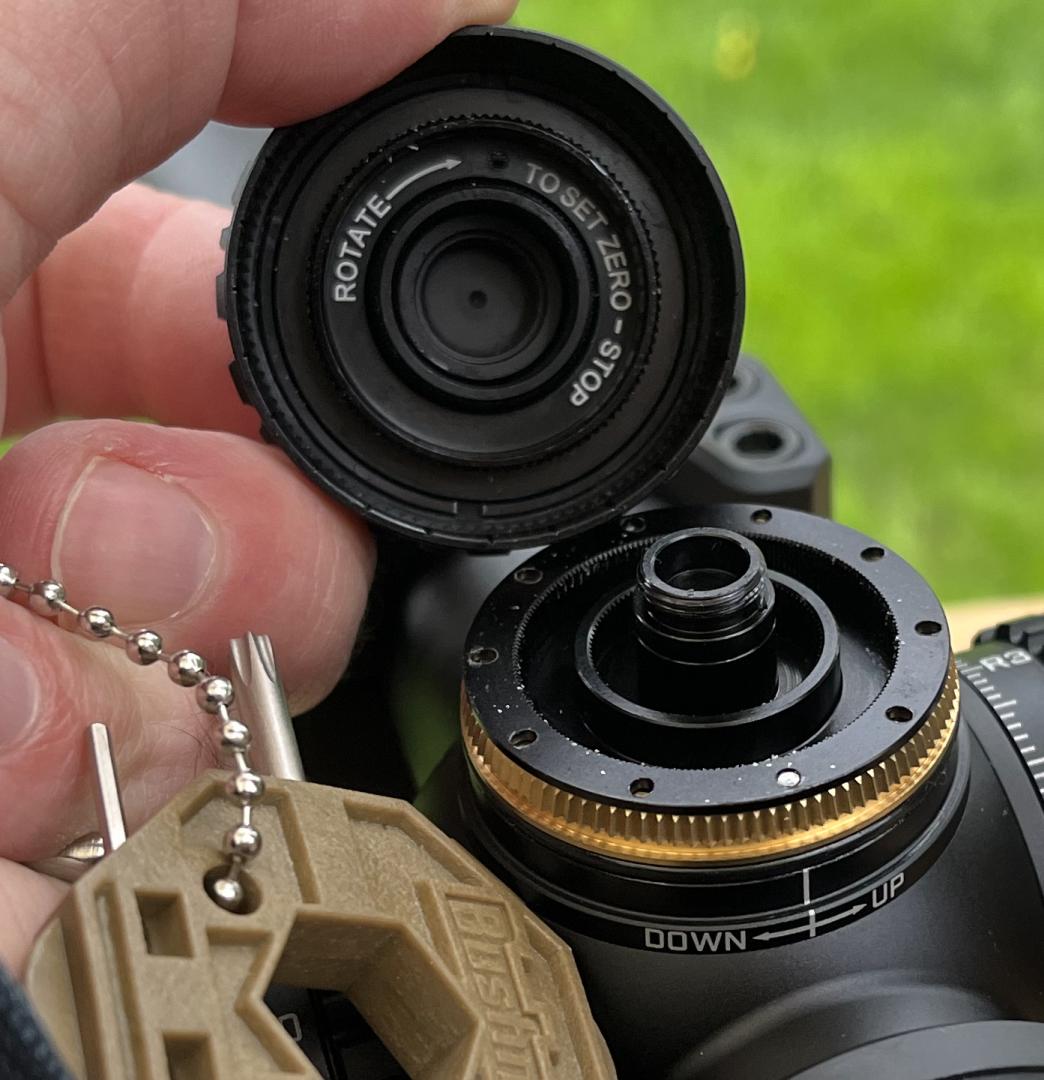
Reticle Options:
At the time of this writing, the Bushnell Match Pro ED 5-30x56mm comes in just one reticle. Interestingly, it’s not the G4P reticle from its sister scope, the XRS3. Instead, it is a new mil tree reticle called the Deploy Mil 2, or DM2. This is an almost entirely .2 mil graduated reticle with just a small .1 mil graduated section 4 mils below the central aiming point in the tree section. This tree section is very complete. It starts with a full 3 mils each way just 1 mil below the horizon and is fully graduated all the way down to 20 mils, at which point it gives you 5 mils left and right. All of this is graduated with the same .2 mil increments as the main crosshairs. My thought when I saw it was mil-grid ,and it is certainly going that way in terms of how much tree feature you have. The line thickness is thicker than typical for a grid reticle, though, and it does not have the vertical dots each mil, as on a grid. To me, there is a bit much tree / grid but I do appreciate the simplicity of the universal .2 mil graduation scheme.
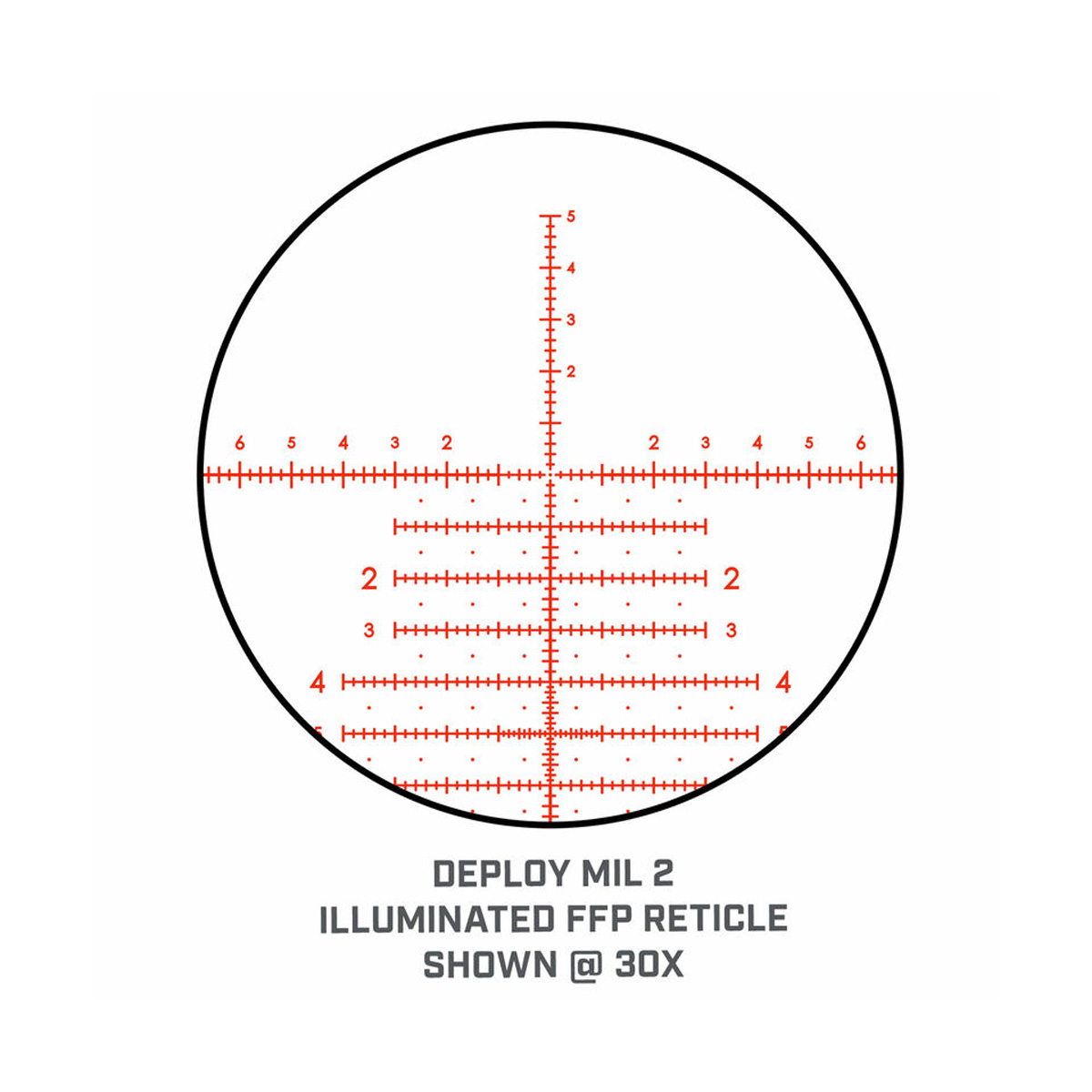
In my test scope, the reticle size was larger than spec by 1%, with 10.0 mils on a calibrated target only measuring 9.9 mils on the reticle. This will be within tolerance for most makers and the reticle showed no measurable cant.
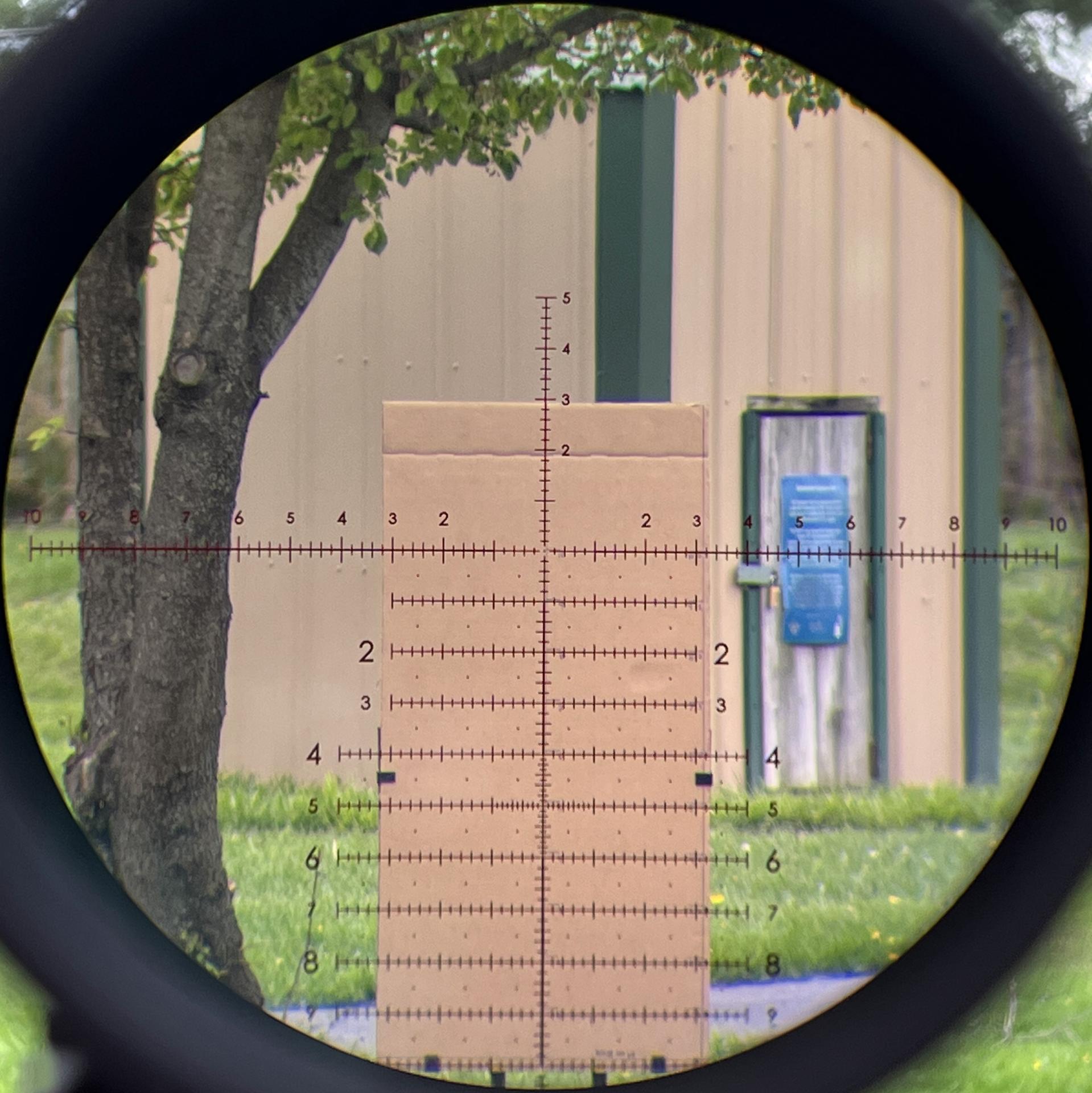
Comparative Optical Evaluation:
It’s always interesting how expectations color our analysis of data. A couple years ago, when I reviewed the big brother to this Bushnell Match Pro ED 5-30x56mm, theBushnell Elite Tactical XRS3 6-36x56mm, I wasn’t expecting it to be the best optical performer in the lineup. Given that it was the lowest cost option in the lineup, has a high erector ratio, and is also a physically short scope, I expected its performance to be in the lower half of the group. As a result of these expectations, I was really blown away when the XRS3 proved to be the best scope optically of the bunch. I think that surprise really enhanced my overall opinion of the scope and I came away remembering the optical performance and price perhaps more than the high weight and feature poor adjustments.
My surprise at the optical performance of this Bushnell Match Pro ED 5-30x56mm is the opposite story. Because of the XRS3, I expected it to be class-leading and it is not. The thing is, the match pro ED is optically fine and has some exceptional features that will probably leave you caring little for the fine points of optical performance anyway. I just expected it to be optically exceptional and it’s not. In hindsight, I didn’t even have a good reason for my expectations. The Match Pro ED is not made in the same factory as the XRS3 or even in the same country. It’s probable that it’s not even contracted from the same OEM, as Bushnell uses many. I had no good reason for my expectation and it shouldn’t be coloring my opinion. Optically, the Match Pro ED 5-30×56 is fine. Let’s get into how that breaks down next to all the comparison scopes, a few of which were:
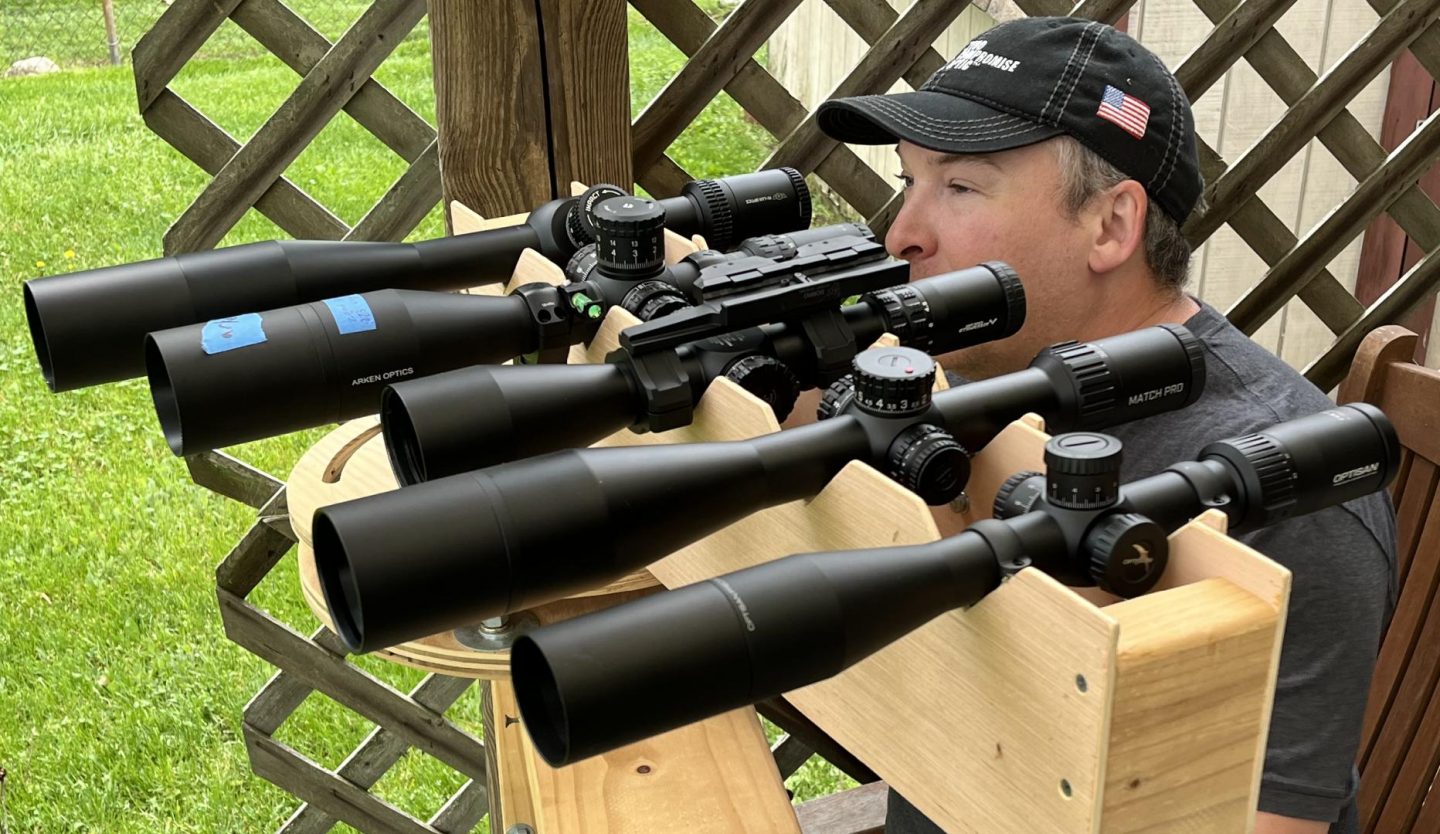
In addition to those, I also added the Athlon Midas TAC 6-24×50 as it is one of the closest scopes to the Match Pro in price and market position. Optically, the Bushnell Match Pro ED 5-30x56mm was in the middle of the pack on a lot of the major points of evaluation. This was true for resolution, depth of field, and contrast. Those are some pretty important aspects of optical performance there. On low light performance, the Bushy was actually #1, but its performance fell below average on eyebox, pincushion / barrel distortion, and chromatic aberration, where it was actually last place. Though, I wouldn’t call it objectively poor at handling chromatic aberration: It was ok, others were just better.
In a nutshell, that isn’t a bad summary of the overall optical performance of the Bushnell Match Pro ED 5-30x56mm. It is ok. It is worlds above the Primary Arms offerings, for instance, and a little better than the Arken. However, it’s not leading the class here and is a little behind the Athlon Midas TAC, to which it will probably be most closely compared, as well as the Hi Luxe and Optisan offerings that are less direct competition.

Mechanical Testing:
Most scopes have some deviation from perfect adjustment magnitude, though they are doing far better now than just a few years ago. This adjustment magnitude error will vary from example to example within the same model of scope. This is because it is not a product of design errors but rather variances introduced within manufacturing and, particularly, the assembly. Thus, the performance of my test samples is a piece of information with only limited value due to representing only one example. Often, we measure adjustment magnitude error as a percentage such that a scope whose reticle moves 10.1 mils when adjusted 10.0 mils tracks at 101% and one whose reticle moves 9.9 mils when 10.0 is dialed tracks at 99%. Frank has helpfully compiled a list of adjustment deviation of all scopes he has tested in class that can give you an idea of how often, and by how much, adjustment magnitude deviates from ideal.
When adjusting up from zero, the Match Pro ED 5-30x56mm I tested read 10.15 mil on target when adjusted 10.0 mils on the knob. This equates to 101.5% on Frank’s scale and represents probably about average for scope adjustment magnitude performance these days. Total adjustment range up from zero was 15.0 mils. Adjusting down from zero, the match pro goes to 14.4 mils on the adjustments and shows the same 1.5% deviation as when adjusting up. This adds up to something like 29.4 total mils of adjustment, though the zero stop system limits it to somewhere around 26 mils.
As with many optics these days, the Bushnell Match Pro ED 5-30x56mm employs a rotation limiter on the windage to prevent you from tubing out and thinking you are pointing at a different place then you are. This revolution limiter gives you about 7.7 mils each way from optical center. In practice, this does not totally prevent tubing out when at max elevation adjustment. At max elevation you get about 5.4 mils and then you see the reticle movement start to tube out. Most scopes show this sort of tubing out at max adjustment, but it is an important thing for shooters to understand as, in a very specific and unusual circumstance, it causes scopes to behave in a way different from how they would be expected to.
Lastly, the Bushnell Match Pro ED 5-30x56mm showed no POI shift with power ring, parallax, or diopter adjustment and no noticeable spline slop. Its reticle showed 1% error in size with 10.0 mils on the reticle being 9.9 mils on the target. This would be within acceptable tolerances for most manufacturers. The reticle had no measurable cant relative to the adjustments. Overall, the Bushnell Match Pro ED 5-30x56mm I tested is within compliance with what I expect are the acceptable tolerances for most precision rifle manufacturers on all of these aspects of mechanical performance. I wouldn’t call it an impressive performance though, merely adequate.
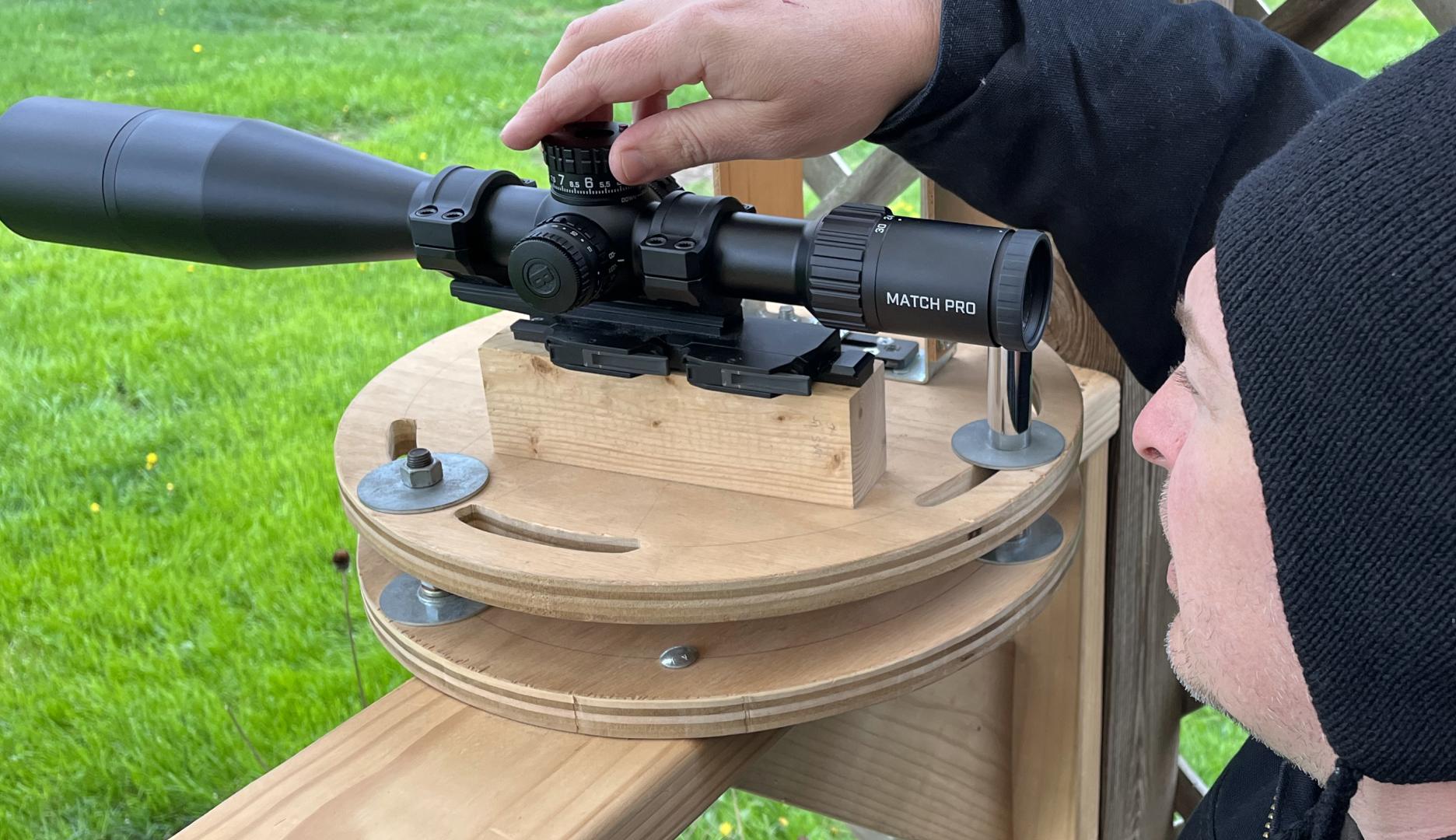
Summary and Conclusion:
After seeing the Easy-SetTM elevation knob design on this Bushnell Match Pro ED 5-30x56mm, I actually shot off a couple e-mails to makers of higher cost scopes to give them the heads up that they had been owned by a $700 scope and needed to adjust their thinking about what makes a good elevation knob. The rich features, simple cost-effective construction, and removal of infuriating setscrews makes this knob design the best overall that I have seen. Bushy should immediately put it in the XRS3 line as well. It is a win and, if they changed the coin slot on the top to a little wingnut style protrusion, it could easily even be totally toolless. In terms of simplicity to set, cost to manufacture, and overall capabilities, the Easy-SetTM system is probably the best elevation knob design at any price and should reset our expectations accordingly. It is probably also the reason to buy the Match Pro ED 5-30x56mm scope.
This brings us to the rest of the scope, which is… fine. It weighs about what you expect, is about the size you expect, has illumination, close focus, and a re-positional throw lever (they dropped the ThrowhammerTM moniker for this feature that I mocked last time) like you would expect. Optically, it is fine; sort of middle-of-the-road for its price class. It has ~29 mil of adjustment, focuses down to very close to 15yds, and it’s made in China. This is all pretty much what you would expect from a $700 precision rifle scope that incorporates all the popular features of the day.
So, what do you get when you check all the boxes and then add the best elevation knob design at any price to a $700 scope? I expect you get a scope that sells like crazy and a lot of happy customers. Hopefully, I also get a lot fewer tiny little hex wrenches littering my review desk in future years. You know, I have to put the damn things in little tiny bags with Sharpie labels on detailing which scope they go with to keep track.
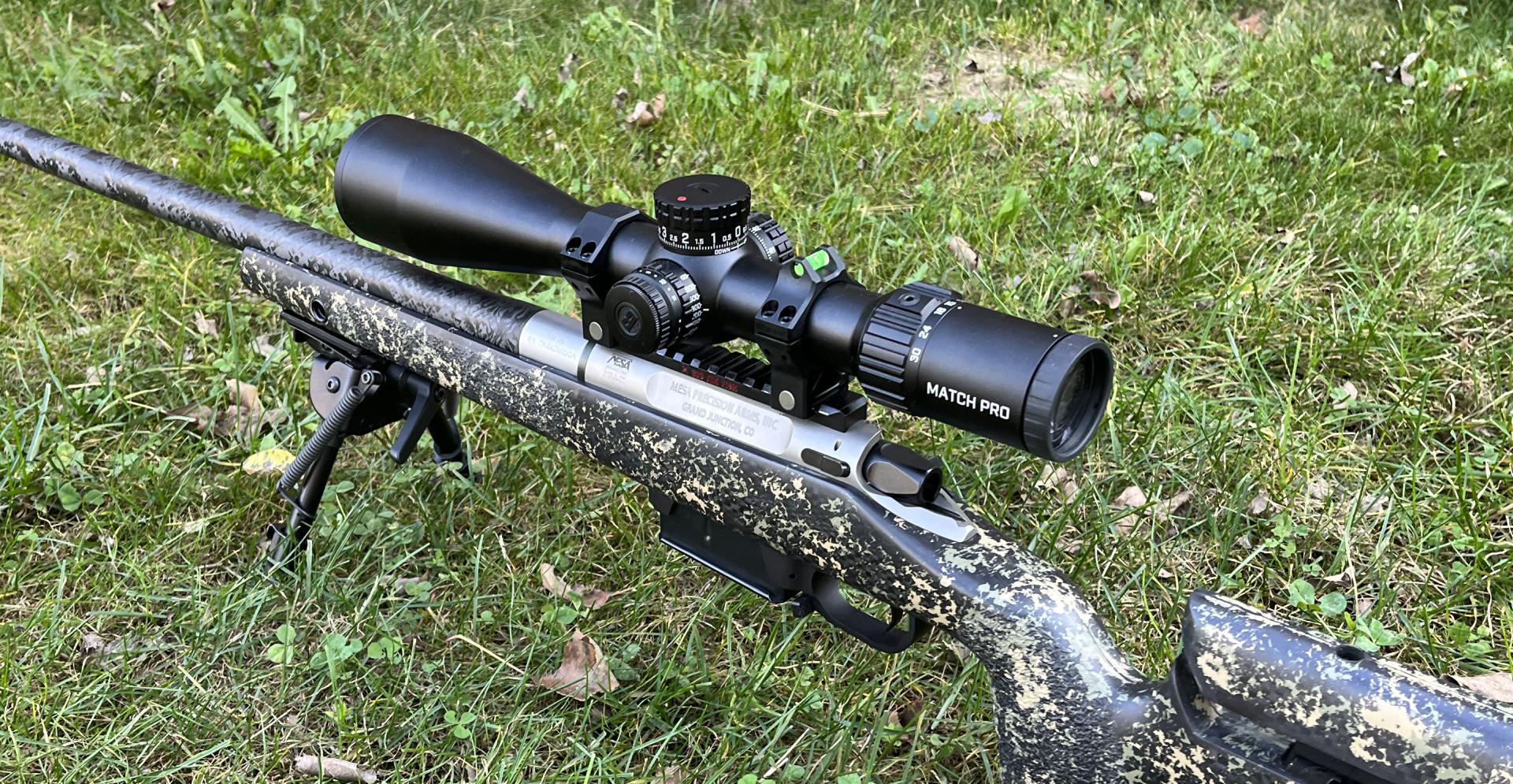
Your Pro and Con Breakdown:
Pros:
– Best zero stop system / elevation knob design I have ever seen with no cursed set screws
– Has all the dejure features, thow-lever, ffp, close focus, 30mils travel, etc.
– Large, 6x erector ratio
– The lifetime warranty you expect
– Comes with sunshade, an always underrated piece of kit
Cons:
– Made in China

